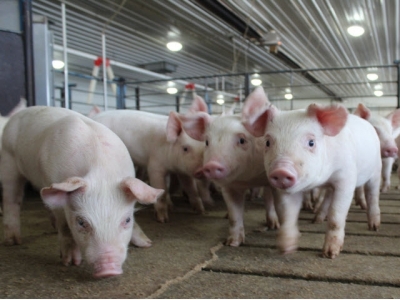Spray-dried plasma may improve piglet performance, feed intake

Adding spray-dried plasma may support feed intake, weight gain and reduce diarrhea for piglets when mycotoxins are present in feed, say researchers.
A team of researchers from the University of the State of Santa Catarina, Federal University of Santa Maria, the University of São Paulo and the Brazilian research organization EMBRAPA, examined the use of spray-dried porcine plasma (SDPP) in mycotoxin-contaminated diets for piglets. The group published its work in the journal Microbial Pathogenesis.
“This study was carried out to evaluate the effects and economic viability of spray-dried porcine plasma in enhancing performance and reducing the incidence of diarrhea in weaned piglets exposed to diets containing aflatoxins and fumonisins,” they said.
The researchers found that use of the feed additive improved overall piglet performance although mycotoxin presence did tend to reduce weight gain at the end of the feeding trial, they said. “Mycotoxins reduced weight gain in the third period,” they added.
“The addition of SDPP promoted an increase in feed intake and weight gain, as well as reduced incidence of diarrhea in piglets, in the context of natural contamination or co-contamination with aflatoxins and fumonisins,” the researchers concluded.
1/ Why plasma and mycotoxins?
In swine production, the weaning period is critical as it contains several stressors including introduction to new piglets, changing environments and a switch from liquid to solid feed, the researchers said. The challenges often result in a drop in feed intake, slower weight gain and instances of diarrhea.
Additionally, diets for piglets often include corn and soybean meal, which can be contaminated with mycotoxins, they said.
“Mycotoxins are naturally-occurring toxic secondary metabolites, produced by various species of filamentous fungi, including Aspergillus and Fusarium,” they said. “They contaminate agricultural crops prior to harvest or during post-harvest storage.”
A diet contaminated with mycotoxins can lead to a reduction in weight gain, increased inflammation, impairment of immune function and pulmonary, hepatic and cardiovascular injury in pigs, they said. Feed additives that could prevent or limit the negative side effects from mycotoxin presence could improve animal performance and productivity.
One potential additive is spray-dried porcine plasma (SDPP), said the researchers. It is considered a “functional feed” as it has beneficial characteristics and nutritional benefits.
The additive provides high-quality protein, active immunoglobulins and is palatable for piglets, they said. Use in the diet may improve immune function, piglet productivity after weaning and boost weight gain.
2/ Methods and materials
In the study, 56 piglets were given four diets for a period of 15 days, the researchers said. The piglets were tested during two separate periods and a previous study focused on immune functioning can be found here.
The diets were corn- and soybean meal-based and included varying levels of mycotoxins with and without SDPP, they said.
“Different levels of mycotoxins, as well as SDPP were as follows: A) 0% of SDPP and 0.95 μg/kg aflatoxins +450 μg/kg fumonisins; B) 6% of SDPP and 0.95 μg/kg aflatoxins +450 μg/kg fumonisins; C) 0% of SDPP and 300 μg/kg aflatoxins +8000 μg/kg fumonisins; and D) 6% of SDPP and 300 μg/kg aflatoxins +8000 μg/kg fumonisins,” they added.
Diets A and B were based on levels of naturally occurring mycotoxin contamination found regionally, they said. Diets C and D included additional levels of aflatoxins and fumonisins.
Every five days piglets were assessed for feed intake and weight gain, while feed efficiency and the economic viability of using SDPP were calculated, they said. Instances of diarrhea also were noted.
3/ Results
No interactions were noted between mycotoxins and SDPP, potentially indicating that negative effects from mycotoxin presence and positive influence from SDPP were independent, the researchers said. However, feed intake was improved for all diets that included SDPP.
Piglets getting the diets with added SDPP had improved weight gain and feed efficiency throughout the feeding trial, they said. “Individual weight gain over the total period was approximately 1kg higher with SDPP treatment,” they added.
“The most important finding of this study is that treatment with SDPP (6%) increased feed intake and weight gain, possibly as a consequence of improvement in palatability,” they said. “It was also associated with better piglet health status.”
However, piglets getting the diets with added plasma and a lower level of mycotoxin contamination tended to perform better than those getting the plasma and higher level of mycotoxins, they said.
Amount of mycotoxin presence was not found to alter instances of diarrhea, but piglets getting diets with SDPP had a reduced occurrence of diarrhea, said the researchers. Throughout the trial, feed efficiency also was improved in diets with the additive plasma.
When evaluated in terms of the cost of other feed ingredients, SDPP was found to be cost-effective for the majority of the feeding trial, they said. “SDPP was not an economic feasibility during the third period (11–15), but was economically feasible in the periods 1–5, 1–10 days, and during the total period (1–15 days),” they added.
Source: Microbial Pathogenesis
Authors: Lucieli Müller, Diovani Paiano, Jeferson Gugel, William Lorenzetti, Janio Santurio, Fernando Tavernari, Eduardo da Gloria, Matheus Baldissera, Aleksandro Da Silva
Related news
 More studies needed to back up use of antibiotic alternatives in pig diets: review
More studies needed to back up use of antibiotic alternatives in pig diets: review The most commonly used feed additives in pig diets are acidifiers, zinc and copper, prebiotics, probiotics, yeast products, nucleotides, and plant extracts.
 Using organoids to unravel feed efficiency in pigs
Using organoids to unravel feed efficiency in pigs Proof of principle shows organoids may be used to study complex traits like feed efficiency.
 What are the benefits of higher amino acid fortification of pig and poultry diets?
What are the benefits of higher amino acid fortification of pig and poultry diets? Livestock production is expect to double by 2050, but there is little room to expand arable land so reducing farmed animals’ intake of crude protein